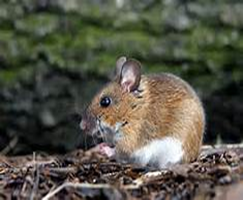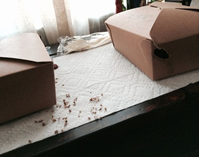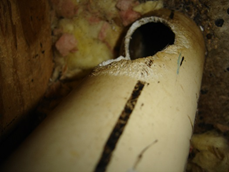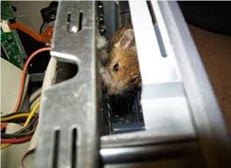Rodents are one of the most important vertebrate pests which directly and indirectly cause distress to the production of crops and storage of grains. Rodents cause severe damage to various crops by gnawing, spoilage, contamination and hoarding activities. The effects of rodent damage cause a huge amount of crop losses and food shortages in many parts of the world. Rodents cause millions of dollars in damages to field crops, stored grain and farm equipment each year. In addition, they are the major carrier for more than 60 diseases that are transmissible to humans, companion animals, and livestock.
In Asia alone, annual food losses due to rodents would be enough to feed 200 million people each year. Rice pre-harvest losses are estimated to be between 5-10% in most Asian countries, however, in some countries, it is expected to be significantly higher, such as Indonesia where yield loss estimates are around 19% which is the equivalent of enough grain to feed 39 million more Indonesians. However, the destruction caused by rodents on a localized level can be devastating where rodent outbreaks can wipe out entire harvests and lead to famine like conditions.
While there are different causes of rodent outbreaks, all lead to a situation whereby there are higher than normal amounts of available food which rodents has access to. Rodent outbreaks have been categorized as being cyclical or evolutional, climatic, or anthropogenic Rodent outbreaks which occur due to natural cycles include the masting or flowering of plants such as bamboo. In 2007, many poor rural communities in India, Myanmar, Bangladesh and Laos PDR were affected by such events and required food aid.
Unusual climatic events such as heavy rainfall early in the wet season or flash floods and cyclones can cause rodent outbreaks. Heavy rainfall before the beginning of the crop season, for instance, can allow the rodents’ breeding season to begin earlier due to better than usual food supply, therefore, the breeding season is extended which increases rodent numbers in the fields.
The third cause of rodent outbreaks is due to the management of cropping systems whereby there is an anthropogenic response to an extreme climatic event or market forces. The expansion of cropping areas and the intensification of cropping systems increasing the number of crop seasons per year are seen as major inducers of anthropogenic rodent outbreaks.
Let us look at some recent news articles pertaining to rodent damage in the agricultural sector.
Rodents destroy crops in district, paddy worst-hit
May 20, 2015, TOI, India
MADURAI: Rodent infestation is causing severe damage to crops across the district, specifically in paddy fields where the damage is estimated to be the highest.
Entomologists said 4.6 to 54% of paddy crops were lost due to rat infestation. The ‘bandicota bengalensis’ variety of rats is the most common troublemaker, found in crop and residential areas alike. These usually thrive in wetland areas. Another species ‘millardia meltada’ is mostly found in dry land areas.
Assistant professor of entomology at Tamil Nadu Agricultural University Usha Rani said, “You know there is a rat problem when the seeds on the planting or the rice tillers, which are grain-bearing branches formed on the base of the plant, are eaten. Rice panicle, which is a kind of flower seen on the top part of the plant, will also be missing.”
“Rodents stock about 0.5kg to 4kg of grain in their burrows in special chambers,” she added.
The rodent problem has been severe in Chellampatti and surrounding areas of the district. Crops are usually damaged when it is about 45 days old. “The maximum damage is caused to rice crops. The rodents cut the seedling in patches,” said farmer from Chellapatti area D Pandiarajan.
Rodents play havoc with paddy ryots
August 4, 2016, TOI, India
Guntur: For J Venkata Rao, a paddy grower from Ponnur mandal in the district, the last couple of years had not been great in terms of returns. While he lost his investment due to lack of adequate rainfall in 2014, rodents ate away a part of his field last year.
This year too, as Kharif season began, he is anxious as he is yet to find an effective method to eradicate the rodents.
“As soon as the transplantation of the crop begins every year, I spend sleepless nights. I grow paddy on 2 acres and I lose about six bags of the crop due to rodents,” he lamented.
Let us now look at some current methods that are used to control the rodent menace in the agricultural sector, particularly in rice fields. Throughout South and Southeast Asia studies have shown that rodents are the number one pest or the pest which causes the most damage to the rice yields. The most common technique used to control the damage caused by rodents is the use of rodenticides. However, studies show that many rodenticides have adverse effects on the health of the farmers. Rodenticides and pesticides also are responsible for the environmental degradation by polluting the soil and ground water reserves. These rodenticides also kill the non-target beneficial species like bees, earthworms etc.
So the question that arises is what should we use? This question has been answered by CTech Corporation’s Combirepel™.Combirepel™ is an extremely low toxicity and extremely low hazard and eco-friendly product of C Tech Corporation that helps to keep rodents at bay.Combirepel™ does not kill the animal, it only repels them! In fact, it is completely safe for the target as well as non-target species. This innovative product, in masterbatch form, can be incorporated with the drip tapes, tubes, pipes, agricultural films, mulches. The product does not leach out, thus preventing soil pollution. Groundwater reserves are also not polluted. Also, the non-target beneficial species like earthworms, bees etc are not affected.
Our product in lacquer form can be coated over tree guards, fences, various PVC surfaces etc. which would ensure complete protection against these creatures. Our products provide a safe and environmentally friendly solution to avoid rodent infestation in agriculture.
The product is compliant with ROHS, ROHS2, ISO, REACH, APVMA, NEA, EU-BPR, and FIFRA exempted.
Contact us at technical.marketing@ctechcorporation.com if you’re facing problems with rodents and get best remedies to combat the pest menace.
Also, visit our websites:
http://www.ctechcorporation.com/
http://www.rodrepel.com/
http://www.termirepel.com/
http://www.combirepel.com/
Follow our Facebook pages at:
1] https://www.facebook.com/Combirepel-411710912249274/
2] https://www.facebook.com/Termirepel-104225413091251/
3] https://www.facebook.com/Rodrepel-120734974768048/
Follow us on our Twitter pages at:
1] https://twitter.com/rodrepel
2] https://twitter.com/termirepel
3] https://twitter.com/combirepel

 The number of hotels infested by rodents is increasing day by day. The adverse impacts of such invasions by these notorious pests not only affect the hotel owners but also the travelers. Hotels have been facing problems due to rodents since long, but the use of appropriate measures to get rid of them is rarely seen.
The number of hotels infested by rodents is increasing day by day. The adverse impacts of such invasions by these notorious pests not only affect the hotel owners but also the travelers. Hotels have been facing problems due to rodents since long, but the use of appropriate measures to get rid of them is rarely seen. In hotels, specific problem areas include poorly sealed heating and air conditioning ducts.
In hotels, specific problem areas include poorly sealed heating and air conditioning ducts. It is surprising that many are unknown to a rodent called vole which is so widespread and poses a huge potential of causing an extensive damage to trees, lawns and gardens. They have even managed to put the blame for their destructive acts on moles, which do not even eat plants as voles do!
It is surprising that many are unknown to a rodent called vole which is so widespread and poses a huge potential of causing an extensive damage to trees, lawns and gardens. They have even managed to put the blame for their destructive acts on moles, which do not even eat plants as voles do! You can find rats or mice entering your house even when you have designed a rodent-proof house?!
You can find rats or mice entering your house even when you have designed a rodent-proof house?! Many a times rodents gnaw on water supply pipes making holes in them. This results in unnecessary flow and wastage of water.
Many a times rodents gnaw on water supply pipes making holes in them. This results in unnecessary flow and wastage of water. A gas leakage is among the most feared human calamities of all time. Be it the poisonous gas leakages, the cooking gas leakages or the petroleum gas leakages. Each and every gas leakage brings with it the insurmountable wreckage of life and surroundings. There is no need to give an introduction into the world of grief provided by gas leakages. Let’s have a look at one such incident.
A gas leakage is among the most feared human calamities of all time. Be it the poisonous gas leakages, the cooking gas leakages or the petroleum gas leakages. Each and every gas leakage brings with it the insurmountable wreckage of life and surroundings. There is no need to give an introduction into the world of grief provided by gas leakages. Let’s have a look at one such incident. Mandhare said, “The petroleum company has informed us that the rubber tube was bitten by a mouse and had a 2mm hole. Probably, Sunita did not notice the hole. Also, the ventilation in the house was poor as the kitchen window was closed and the door was locked. However, the cylinder and regulator were intact” .
Mandhare said, “The petroleum company has informed us that the rubber tube was bitten by a mouse and had a 2mm hole. Probably, Sunita did not notice the hole. Also, the ventilation in the house was poor as the kitchen window was closed and the door was locked. However, the cylinder and regulator were intact” .